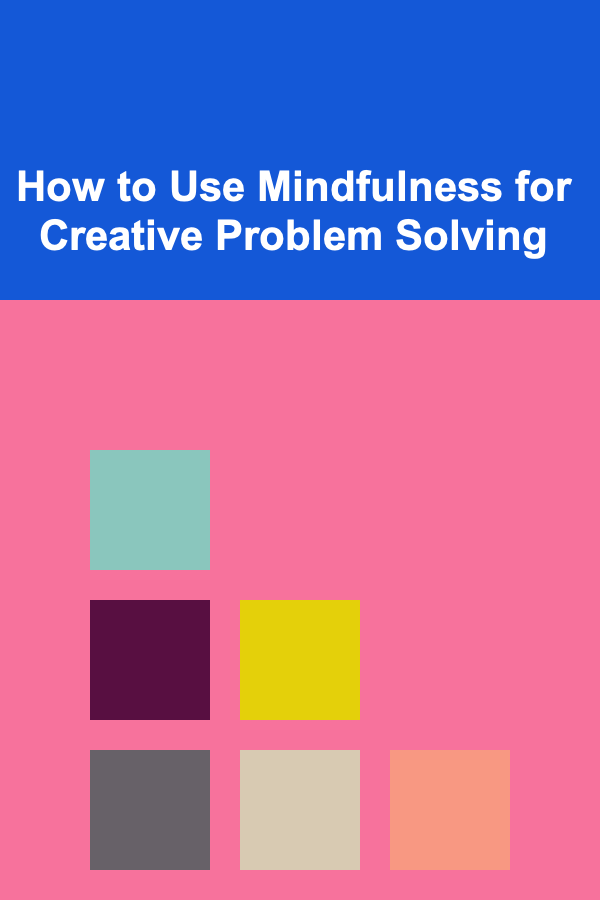
How to Use Mindfulness for Creative Problem Solving
ebook include PDF & Audio bundle (Micro Guide)
$12.99$10.99
Limited Time Offer! Order within the next:

Creativity is often seen as an inherent trait---something that a select few are born with. However, creativity is a skill that can be nurtured, developed, and enhanced over time, especially when it is paired with the right mindset. One such mindset that has gained significant attention in recent years is mindfulness. Mindfulness, a practice rooted in ancient meditation techniques, involves focusing on the present moment without judgment. This powerful mental state can be an invaluable tool for creative problem solving.
In this article, we will explore how mindfulness can be applied to creative problem solving. We will break down the benefits of mindfulness, explain how it can be integrated into the creative process, and offer practical tips and exercises to help you tap into your creativity. Whether you're an artist, entrepreneur, scientist, or simply someone who wants to improve their ability to think creatively, mindfulness can be the key to unlocking new solutions and ideas.
Understanding Mindfulness
Mindfulness, at its core, is the practice of paying attention to the present moment with intention, awareness, and without judgment. It is often associated with meditation, but mindfulness extends far beyond the cushion. It can be applied to all aspects of daily life---whether you're eating, working, or interacting with others. The fundamental aspects of mindfulness are:
- Awareness: Being aware of your thoughts, emotions, sensations, and surroundings in the present moment.
- Non-judgment: Observing these thoughts and sensations without labeling them as good or bad.
- Intention: Approaching your experiences with a sense of purpose and openness.
Research has shown that regular mindfulness practice can reduce stress, improve focus, enhance emotional regulation, and increase overall well-being. It allows individuals to step outside of their habitual patterns of thinking and view situations from a fresh perspective. This is particularly important when it comes to creative problem solving, as the ability to think outside the box and approach challenges from new angles is essential for innovation.
The Link Between Mindfulness and Creativity
Creativity is the process of coming up with new and valuable ideas. It involves the ability to make connections between seemingly unrelated concepts and think in novel ways. However, creativity is often hindered by mental blocks, stress, and anxiety. The mind becomes clouded with self-doubt, past experiences, and fear of failure, preventing the free flow of innovative ideas. Mindfulness helps to clear away these mental barriers and creates the space for creative ideas to flourish.
How Mindfulness Enhances Creativity
- Increases Focus and Attention
Creativity thrives in an environment where the mind is focused and attentive. Mindfulness trains the brain to stay present and focused on the task at hand, reducing distractions and mental clutter. When your mind is focused, you're better able to dive deeply into creative tasks without being sidetracked by irrelevant thoughts or external distractions.
- Reduces Stress and Anxiety
Stress and anxiety are significant barriers to creativity. When you're stressed, your brain's ability to think clearly and solve problems is compromised. Mindfulness reduces stress by promoting relaxation and calming the nervous system. When the body is relaxed, the brain is free to explore ideas and solutions without the interference of tension and worry.
- Improves Emotional Regulation
Creativity is closely tied to emotions, and emotional states can either facilitate or hinder creative thinking. Mindfulness helps individuals regulate their emotions by fostering a non-judgmental awareness of their feelings. Instead of reacting impulsively to emotional triggers, mindfulness enables a thoughtful response, allowing for clearer thinking and better decision-making during the creative process.
- Encourages Open-Mindedness
Mindfulness cultivates an open mind, free from preconceived notions and biases. This open-mindedness is essential for creative problem solving, as it allows individuals to approach challenges with curiosity and a willingness to consider multiple perspectives. When you're not attached to a particular outcome, you're more likely to find innovative solutions that may have been overlooked.
- Promotes Divergent Thinking
Divergent thinking is the ability to generate multiple possible solutions to a problem. Mindfulness encourages this type of thinking by helping individuals step away from linear, goal-oriented thinking and embrace more fluid, expansive thinking. By quieting the inner critic and judgmental thoughts, mindfulness allows the mind to wander freely and explore various possibilities.
- Enhances Problem-Solving Skills
Creative problem solving involves more than just generating ideas; it requires the ability to analyze, evaluate, and refine those ideas. Mindfulness improves problem-solving skills by helping individuals break free from rigid thought patterns and approach problems with a fresh perspective. It enables individuals to view problems from different angles, identify underlying assumptions, and consider alternative solutions.
Integrating Mindfulness into the Creative Problem-Solving Process
Now that we understand the benefits of mindfulness for creativity, let's explore how to integrate it into the creative problem-solving process. Whether you're tackling a challenging work project, trying to come up with a new product design, or looking for innovative solutions to personal problems, mindfulness can enhance your ability to think creatively and find effective solutions.
Step 1: Set the Intention for Creative Problem Solving
Before you begin any creative task, set an intention to approach it with mindfulness. This intention should be to stay present, let go of judgment, and embrace new ideas without resistance. It's important to remind yourself that the process is just as important as the outcome. Creativity often involves trial and error, and by setting the intention to be open and non-judgmental, you can stay motivated and focused throughout the process.
Step 2: Practice Mindful Breathing to Calm the Mind
One of the easiest and most effective ways to cultivate mindfulness is through mindful breathing. Start by taking a few deep, conscious breaths. Focus your attention on the sensation of the breath entering and leaving your body. As you breathe, try to release any tension or distractions in your mind. This practice helps you to clear your mind and prepare it for creative thinking. When you're calm and centered, you're more likely to think clearly and generate ideas.
Step 3: Engage in Mindful Observation
Mindful observation is the practice of paying close attention to your surroundings without judgment. Take a moment to observe your environment and the task at hand. Notice the details, textures, colors, sounds, and sensations that may otherwise go unnoticed. By fully engaging your senses, you may find inspiration or new insights that can spark creative ideas. This practice encourages you to observe problems from different angles and consider alternative perspectives.
Step 4: Let Go of Perfectionism and Judgment
One of the biggest obstacles to creativity is the fear of failure or the desire for perfection. Mindfulness encourages you to let go of judgment and embrace the present moment without criticism. When you create, focus on the process rather than the end result. Allow yourself to experiment, make mistakes, and learn from them. This mindset shifts the focus from getting it right to simply exploring possibilities, which is essential for creative breakthroughs.
Step 5: Practice Mindful Reflection
After you've engaged in the creative process, take a moment to reflect mindfully on your work. Instead of evaluating it with harsh criticism, reflect with curiosity. Ask yourself what you've learned from the process, what worked well, and what could be improved. This reflective practice helps you refine your ideas and deepen your understanding of the creative process.
Step 6: Use Mindfulness to Overcome Creative Blocks
Creative blocks are a common challenge that many people face. When you're stuck and unable to generate new ideas, mindfulness can help you break through the mental barriers. Take a few moments to breathe mindfully, clear your mind, and let go of any frustration or impatience. Sometimes, simply stepping away from the problem and returning to it with a calm, clear mind can help you see things in a new light.
Step 7: Incorporate Mindfulness into Collaborative Problem Solving
Mindfulness can also enhance creativity in group settings. When working with others, encourage mindful listening and communication. This involves giving your full attention to others, being open to their ideas, and responding without judgment. Group brainstorming sessions can be more effective when all participants are fully present and actively engaged in the process. By cultivating a mindful and collaborative environment, you can generate more creative and diverse solutions.
Mindfulness Exercises to Enhance Creativity
To deepen your mindfulness practice and enhance your creative problem-solving skills, try incorporating these mindfulness exercises into your routine:
1. Body Scan Meditation
This practice involves scanning your body from head to toe, noticing any areas of tension or discomfort, and releasing them with each breath. The body scan helps cultivate awareness of the present moment and can be a powerful way to reduce stress before engaging in creative tasks.
2. Mindful Walking
Take a walk outside and focus on the sensations of each step. Notice the ground beneath your feet, the rhythm of your movement, and the sights and sounds around you. Walking mindfully helps clear the mind and stimulates creative thinking by engaging your senses.
3. Journaling
Set aside time each day to journal your thoughts and ideas. Write without judgment or editing, allowing your thoughts to flow freely. Journaling can help you process emotions, identify creative insights, and overcome mental blocks.
4. Visualization
Close your eyes and visualize a creative problem or challenge. Imagine possible solutions without any limitations or restrictions. Visualization helps you explore new ideas and envision creative outcomes.
5. Mindful Breathing with Focused Attention
Practice mindful breathing while focusing on a particular idea or problem. As you inhale, focus on a potential solution. As you exhale, release any doubts or negative thoughts. This exercise helps align your focus and calm your mind for creative problem-solving.
Conclusion
Mindfulness is a powerful tool for enhancing creativity and problem-solving abilities. By cultivating awareness, reducing stress, and encouraging open-mindedness, mindfulness helps you approach challenges from a fresh perspective. Integrating mindfulness into the creative process can lead to more innovative ideas, improved decision-making, and a deeper sense of satisfaction with your work. Whether you're facing a personal dilemma or a professional challenge, mindfulness can provide the clarity and insight needed to unlock your creative potential and find effective solutions.

How to Care for Hardwood Floors: Maintenance and Cleaning Tips
Read More
How to Make a Yearly Photo Album for Easy Reflection
Read More
How to Organize Your Board Games for Family Fun
Read More
How to Plan Pantry Meals with What You Have on Hand
Read More
Investing in Penny Stocks: A Deep Dive into High Risk, High Reward
Read More
How to Get a Co-Signed Credit Card
Read MoreOther Products

How to Care for Hardwood Floors: Maintenance and Cleaning Tips
Read More
How to Make a Yearly Photo Album for Easy Reflection
Read More
How to Organize Your Board Games for Family Fun
Read More
How to Plan Pantry Meals with What You Have on Hand
Read More
Investing in Penny Stocks: A Deep Dive into High Risk, High Reward
Read More